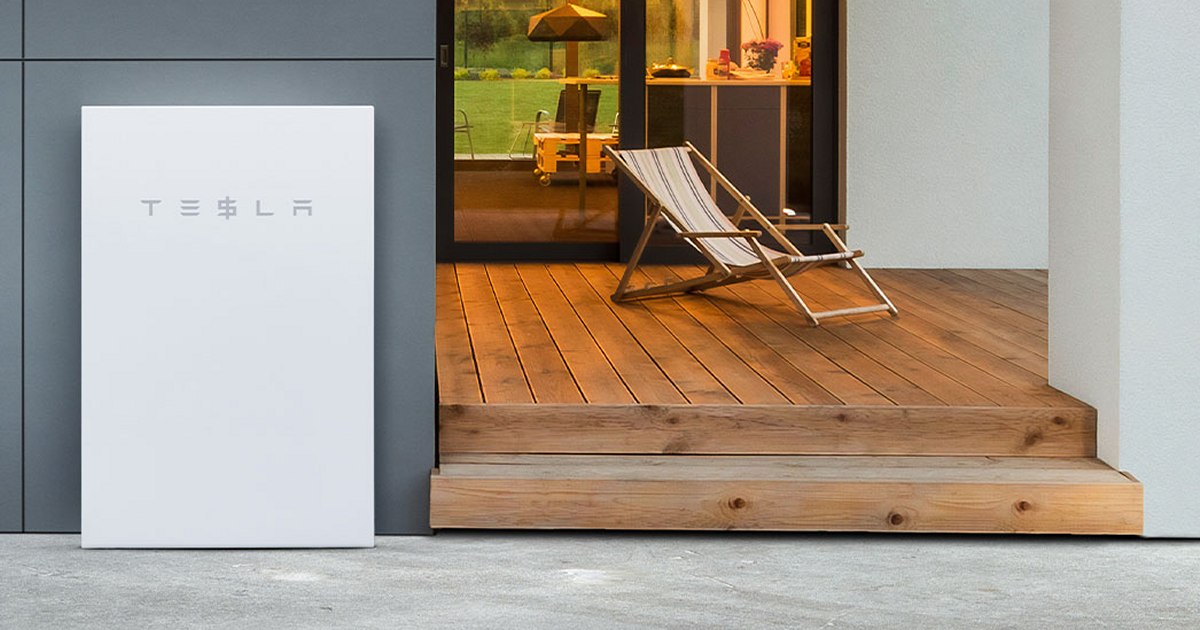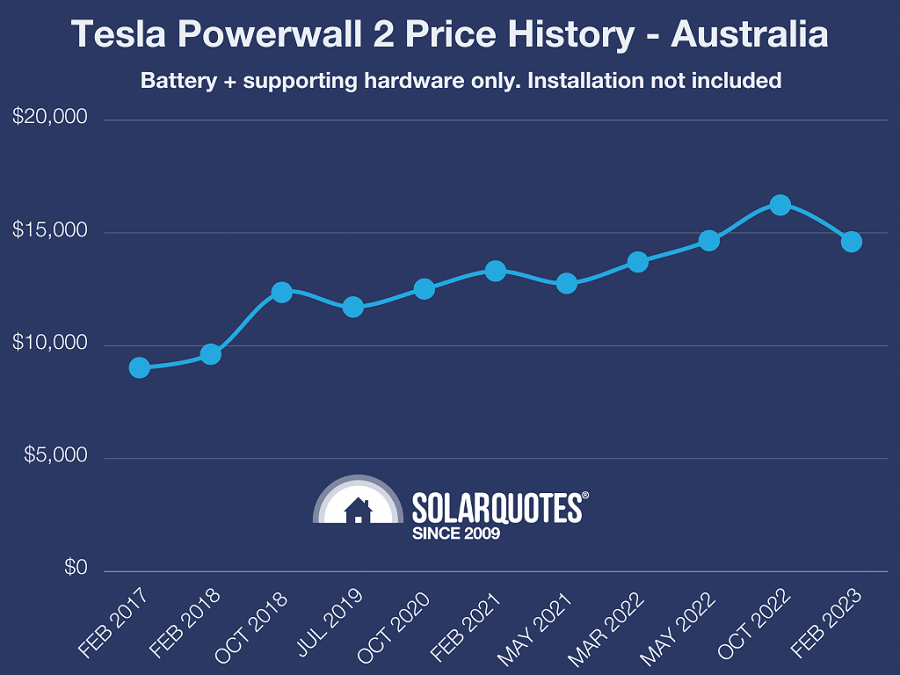Shock! Horror! But in a good way. Rumours of a Tesla Powerwall price drop turned out to be correct. Now it’s just expensive.
Since originally released around 6 years ago, Powerwall (2) has proven very popular in Australia. There were hopes the arrival of Powerwall on the scene would accelerate price reductions in solar battery storage. And it looked like this would be the case for a short while when you could get one installed for under $10,000.
But in 2018 the price jumped significantly. There were more increases than decreases from that point and the cost of Powerwall shifted into ludicrous mode late last year. In October 2022, it jumped to more than $16,000 *without* installation. However, after three consecutive price increases over a period of 7 months, good news arrived late last week in an email from Tesla to installers, which stated:
“We are pleased to inform you that due to ongoing improvements in supply chains and foreign exchange, the price of Powerwall will decrease as of Friday 24th February 2023.”
The reduction isn’t just a token amount – it has dropped from a previous recommended retail price of $16,230 inclusive of GST to $14,599; so a reduction of $1,631. That’s on par with pricing in May last year, but still significantly more than it was prior.
And on that note..
Tesla Powerwall Price History
The following are Australian pricing movements on Powerwall we’ve been tracking over the years. Note the prices are for the battery and supporting hardware only. Installation can whack on a couple of thousand dollars these days even for a reasonably straightforward installation.
- February 2017 (est.): $9,000
- February 2018: $9,600
- October 2018: $12,350
- July 2019: $11,700
- October 2020: $12,500
- February 2021: $13,300
- May 2021: $12,750
- March 2022: $13,700
- May 2022: $14,650
- October 2022: $16,2301
- February 2023: $14,599
We’ve also updated our spiffy graph to include the latest price change.
Which Way Will Powerwall Prices Go Next?
If you’re considering holding off buying a Tesla Powerwall in the hope of further price decreases in the not-too-distant future, as the good book counsels: “For who has known the mind of Elon Musk, so as to instruct him?”. I think I’ve quoted that correctly.
As you can see from the list and graph above, Powerwall pricing has been a bit all over the place and that could continue. But here’s hoping the latest change is the start of a downward trend.
Also bear in mind Tesla isn’t the only solar battery brand around. There are a bunch of other home energy storage options available in Australia. Back in November, SQ’s Anthony provided details on eight Powerwall alternatives to consider.
And before you whack down a wad of bucks on a Powerwall or any other battery system for that matter, check out SolarQuotes founder Finn’s guide to buying solar batteries.
Footnotes
- Originally we had the October 2022 Powerwall price noted as $16,500, but Tesla’s email seems to indicate it was $16,230. Perhaps there was a small price drop we missed. ↩



 RSS - Posts
RSS - Posts



Good news. It’s interesting that government subsidy for solar is still mostly for generation, and not for storage. Given the problems ‘solar taxes’ are now under discussion about, to curb some export to the grid, it seems strange that they don’t alter the subsidy regime a little more, to include storage as well.
Maybe for grid engineering reasons they don’t want too much personal storage on the grid, who knows.
We run holiday accomodation and put in both panels and batteries plus changeover the gas hws to 310 litre electric units on timer. Pay back is now about 4 years. No annual bill. Over a 2 year time frame it started with first lot of panels, then later more panels and batteries, then adding the cheapest electric hws with timers. Now we net export about 7 times what we draw back. It was not rocket science but was best to take it gradually so we saw our usage and production patterns over time
Kevin
for cars a tesla battery pack cost around US$150 per kw.
so 10 kw will cost $ 1500.
Add the inverter to than, casing etc and your price should be max $5000.
I never understood why home batteries are so expensive.
Just looking at cost price of raw materials the only conclusion if high margin, very high margin.
A few things. The powerwall is 13.5kWh of useable storage, so I guess probably about 15kWh total. There is also the costs for the backup gateway, battery management and battery cooling. If you were to add another powerwall battery to an existing system I believe the cost would only be about 70% of the initial cost since you don’t need to buy the gateway, inverter, software, etc. But yes you are still right. It still seems like they could be a lot cheaper and I think the cost is currently still being mostly set by the supply versus demand equation.
In what way does that price graph look “all over the place?”
It’s been consistent price increases all the time — it’s a very clear upslope.
Either the lithium battery is the only technology mankind has ever developed which gets more expensive as it matures, or Tesla is profiteering.
In reality, Powerwall is Tesla’s way of selling the battery cells which don’t meet the quality bar necessary for an electric car. It’s a yield amplifier, enabling them to charge a premium price for a product that’d otherwise be rejected.
Furthermore, the supply of reject cells should be increasing as their car business expands.
So everything SHOULD be set up for the price of Powerwalls to fall precipitously.
But they aren’t, because Tesla doesn’t face realistic competition and can set whatever price it needs to drive its profit margins. And then the rest of the market follows, because why on earth wouldn’t they?
kWh storage should be a fraction of its current price. The fact that it isn’t is holding back the migration that needs to happen to drive renewables into our economy, and Tesla should be heavily criticized for that.
The changes the new Nevada gigafactory will bring to battery prices has some analysts saying companies like Toyota may cease to exist, massive changes afoot. A base model Tesla Model 3 already has a lower 5-year cost of ownership than a Toyota Corolla. With the third generation platform they’re launching, including massive drops in projected battery costs, many industry analysts say it’s difficult seeing some traditional car manufacturers surviving. Can only assume some of these economies of scale will flow through to the Powerwall as well.
Please check out the fx changes from 2013 till 2023 on the AUD:USD cross rate. You will find 9000 USD = 8700 AUD in 2013. Today 9000 USD is 13,500 AUD
Will get one once they drop in price as pay back for a normal home is not there at current feed in tariff rates.